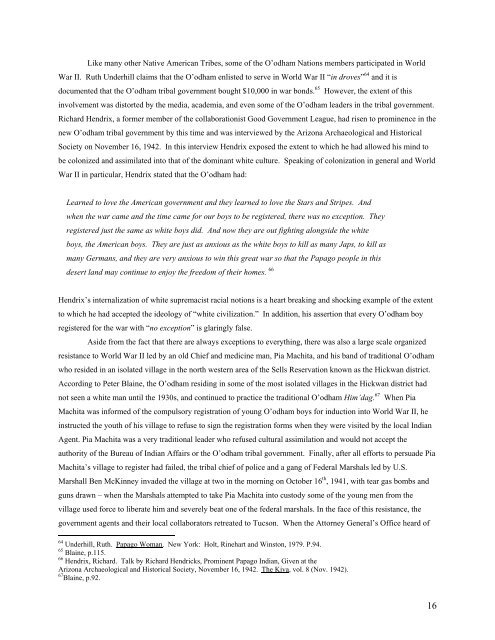Resistance and Collaboration: O'odham Responses to U.S. Invasion
Resistance and Collaboration: O'odham Responses to U.S. Invasion
Resistance and Collaboration: O'odham Responses to U.S. Invasion
Create successful ePaper yourself
Turn your PDF publications into a flip-book with our unique Google optimized e-Paper software.
Like many other Native American Tribes, some of the O’odham Nations members participated in World<br />
War II. Ruth Underhill claims that the O’odham enlisted <strong>to</strong> serve in World War II “in droves” 64 <strong>and</strong> it is<br />
documented that the O’odham tribal government bought $10,000 in war bonds. 65 However, the extent of this<br />
involvement was dis<strong>to</strong>rted by the media, academia, <strong>and</strong> even some of the O’odham leaders in the tribal government.<br />
Richard Hendrix, a former member of the collaborationist Good Government League, had risen <strong>to</strong> prominence in the<br />
new O’odham tribal government by this time <strong>and</strong> was interviewed by the Arizona Archaeological <strong>and</strong> His<strong>to</strong>rical<br />
Society on November 16, 1942. In this interview Hendrix exposed the extent <strong>to</strong> which he had allowed his mind <strong>to</strong><br />
be colonized <strong>and</strong> assimilated in<strong>to</strong> that of the dominant white culture. Speaking of colonization in general <strong>and</strong> World<br />
War II in particular, Hendrix stated that the O’odham had:<br />
Learned <strong>to</strong> love the American government <strong>and</strong> they learned <strong>to</strong> love the Stars <strong>and</strong> Stripes. And<br />
when the war came <strong>and</strong> the time came for our boys <strong>to</strong> be registered, there was no exception. They<br />
registered just the same as white boys did. And now they are out fighting alongside the white<br />
boys, the American boys. They are just as anxious as the white boys <strong>to</strong> kill as many Japs, <strong>to</strong> kill as<br />
many Germans, <strong>and</strong> they are very anxious <strong>to</strong> win this great war so that the Papago people in this<br />
desert l<strong>and</strong> may continue <strong>to</strong> enjoy the freedom of their homes. 66<br />
Hendrix’s internalization of white supremacist racial notions is a heart breaking <strong>and</strong> shocking example of the extent<br />
<strong>to</strong> which he had accepted the ideology of “white civilization.” In addition, his assertion that every O’odham boy<br />
registered for the war with “no exception” is glaringly false.<br />
Aside from the fact that there are always exceptions <strong>to</strong> everything, there was also a large scale organized<br />
resistance <strong>to</strong> World War II led by an old Chief <strong>and</strong> medicine man, Pia Machita, <strong>and</strong> his b<strong>and</strong> of traditional O’odham<br />
who resided in an isolated village in the north western area of the Sells Reservation known as the Hickwan district.<br />
According <strong>to</strong> Peter Blaine, the O’odham residing in some of the most isolated villages in the Hickwan district had<br />
not seen a white man until the 1930s, <strong>and</strong> continued <strong>to</strong> practice the traditional O’odham Him’dag. 67 When Pia<br />
Machita was informed of the compulsory registration of young O’odham boys for induction in<strong>to</strong> World War II, he<br />
instructed the youth of his village <strong>to</strong> refuse <strong>to</strong> sign the registration forms when they were visited by the local Indian<br />
Agent. Pia Machita was a very traditional leader who refused cultural assimilation <strong>and</strong> would not accept the<br />
authority of the Bureau of Indian Affairs or the O’odham tribal government. Finally, after all efforts <strong>to</strong> persuade Pia<br />
Machita’s village <strong>to</strong> register had failed, the tribal chief of police <strong>and</strong> a gang of Federal Marshals led by U.S.<br />
Marshall Ben McKinney invaded the village at two in the morning on Oc<strong>to</strong>ber 16 th , 1941, with tear gas bombs <strong>and</strong><br />
guns drawn – when the Marshals attempted <strong>to</strong> take Pia Machita in<strong>to</strong> cus<strong>to</strong>dy some of the young men from the<br />
village used force <strong>to</strong> liberate him <strong>and</strong> severely beat one of the federal marshals. In the face of this resistance, the<br />
government agents <strong>and</strong> their local collabora<strong>to</strong>rs retreated <strong>to</strong> Tucson. When the At<strong>to</strong>rney General’s Office heard of<br />
64 Underhill, Ruth. Papago Woman. New York: Holt, Rinehart <strong>and</strong> Wins<strong>to</strong>n, 1979. P.94.<br />
65 Blaine, p.115.<br />
66 Hendrix, Richard. Talk by Richard Hendricks, Prominent Papago Indian, Given at the<br />
Arizona Archaeological <strong>and</strong> His<strong>to</strong>rical Society, November 16, 1942. The Kiva, vol. 8 (Nov. 1942).<br />
67 Blaine, p.92.<br />
16


